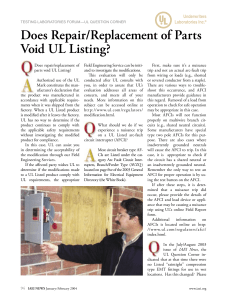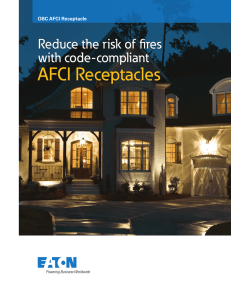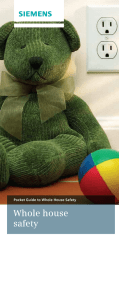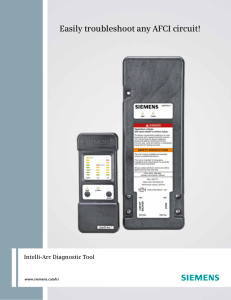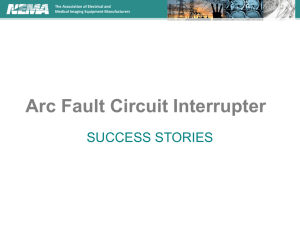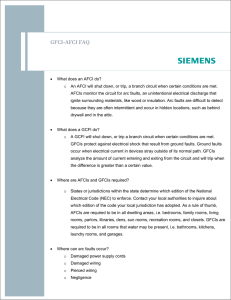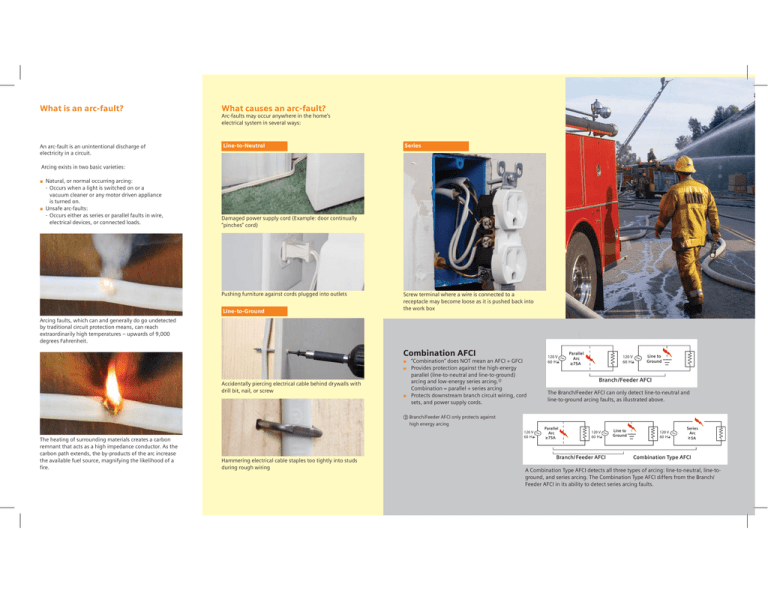
What is an arc-fault?
What causes an arc-fault?
An arc-fault is an unintentional discharge of
electricity in a circuit.
Line-to-Neutral
Arc-faults may occur anywhere in the home’s
electrical system in several ways:
Series
Arcing exists in two basic varieties:
Natural, or normal occurring arcing:
- Occurs when a light is switched on or a
vacuum cleaner or any motor driven appliance
is turned on.
Unsafe arc-faults:
- Occurs either as series or parallel faults in wire,
electrical devices, or connected loads.
Damaged power supply cord (Example: door continually
“pinches” cord)
Pushing furniture against cords plugged into outlets
Line-to-Ground
Screw terminal where a wire is connected to a
receptacle may become loose as it is pushed back into
the work box
Arcing faults, which can and generally do go undetected
by traditional circuit protection means, can reach
extraordinarily high temperatures – upwards of 9,000
degrees Fahrenheit.
Combination AFCI
Accidentally piercing electrical cable behind drywalls with
drill bit, nail, or screw
“Combination” does NOT mean an AFCI + GFCI
Provides protection against the high-energy
parallel (line-to-neutral and line-to-ground)
arcing and low-energy series arcing.햳
Combination = parallel + series arcing
Protects downstream branch circuit wiring, cord
sets, and power supply cords.
햳 Branch/Feeder AFCI only protects against
high energy arcing
The heating of surrounding materials creates a carbon
remnant that acts as a high impedance conductor. As the
carbon path extends, the by-products of the arc increase
the available fuel source, magnifying the likelihood of a
fire.
120 V u
60 H z
Hammering electrical cable staples too tightly into studs
during rough wiring
120 V u
60 H z
Parallel
Arc
≥75A
120 V u
60 H z
Line to
Ground
Branch /Feeder AFCI
The Branch/Feeder AFCI can only detect line-to-neutral and
line-to-ground arcing faults, as illustrated above.
Parallel
Arc
≥ 75A
120 V u
60 H z
Branch/ Feeder AFCI
Line to
Ground
120 V u
60 H z
Series
Arc
≥ 5A
Combination Type AFCI
A Combination Type AFCI detects all three types of arcing: line-to-neutral, line-toground, and series arcing. The Combination Type AFCI differs from the Branch/
Feeder AFCI in its ability to detect series arcing faults.
History of the AFCI
What is unique about
the Murray
Combination AFCI?
LED Indication Guide
(after recent trip has occurred)
During the early to mid 1980s, a United States Fire
Administration (USFA) report helped prompt the U.S.
Consumer Product Safety Commission to investigate deeper
into the causes of electrical fires. The report which was
completed in 1987, concluded electrical fires occurred most
often in branch circuit wiring, followed by receptacle outlets,
and extension cords. Satisfied with the results, in 1994 the
CPSC issued a request to 800 manufacturers to submit any
new technology for evaluation to reduce the risk of electrical fires.
The Arc Fault Circuit Interrupter (AFCI)
technology is important to electrical
contractors as they work to build safe,
efficient electrical distribution systems.
Diagnosing the cause of AFCI trips can
be confusing, but the unique trip
indicators built into every Murray AFCI
offer help that is not available on any
other AFCI.
Turn AFCI to “ON” position. Observe LED indications and
compare to chart below:
The 2005 NEC® requires the Combination Type AFCI
to be implemented January 1, 2008. The proposed
wording for the 2008 NEC will expand protection from
just the bedrooms to all living areas.
AFCIs provide an increased level of safety to the
electrical wiring system.
Statistics: Based on home wiring issues, the U.S. Fire
Administration estimates:
67,800 fires each year햲
485 deaths annually햲
~2,300 injuries annually햲
$868 million in property losses햲
National Electric Code® Progression
1999 NEC®
Listed AFCI future requirement in Code
- Allows Branch/Feeder AFCI
January 1, 2002: bedroom receptacles
2002 NEC®
Listed AFCI in ALL bedroom circuits
- Allows Branch/Feeder AFCI
2005 NEC®
Combination Type AFCI in bedroom circuits
Branch/Feeder AFCI permitted until January 1, 2008
2008 NEC®
Combination Type AFCI
Expand to 1 pole, 15 – 20A circuits installed in family
rooms, dining rooms, living rooms, parlors, libraries,
dens, bedrooms, sunrooms, recreation rooms,
closets, hallways, or similar rooms or areas
closets,
햲 On the Safety Circuit: A Fact Sheet on Home Electrical Fire
Prevention. United States Fire Administration (2006)
Murray Combination Type AFCI trip indicators provide a
valuable analysis tool to help electricians pinpoint the type
of trip. These indicators are in the form of LEDs that appear
near the handle of the breaker. The LED indicators will
appear for 5 seconds each time the AFCI is turned “ON” up
to 30 days after the last trip. One LED will be illuminated
if the last trip was a result of an arcing fault. Two LEDs will
be illuminated if the last trip was a result of an arcing fault
to ground. No indicator will be displayed if the AFCI trips
as a result of an overcurrent condition. The last known trip
indicator can also be manually cleared from memory to
assist with verifying resolution of the problem.
Murray Combination Type AFCI Troubleshooting
Procedure
Murray has developed a step-by-step troubleshooting
procedure that simplifies the process of diagnosing the
cause of AFCI trips. See instruction sheet at
www.murrayconnect.com/afci for more details.
An abbreviated procedure is listed below:
1) Check AFCI wiring
Load power, load neutral, and panel neutral (pigtail)
Multi-wire branch circuits used on single pole AFCI
(dedicated load neutral wires required for single
pole AFCIs)
Check all connection points for neutral-to-ground
connections
2) If load(s) present:
Disconnect all loads
Re-connect and re-energize each load, one at a time
Reduce the risk of electrical fires
LED indications will appear for 5 seconds each time the
AFCI is turned “ON.” Display will appear each time the AFCI
is reset up to 30 days after last trip.
LED Indicator
Last Known Trip Condition
LED (A)
LED (B)
OFF
OFF
Overcurrent
ON
OFF
Arc Fault
ON
ON
Arc Fault to Ground
A
B
The last known trip condition can be cleared by the
following process:
1 Turn the AFCI to the “OFF” position.
2 Press and hold the PTT button.
3 Turn the AFCI to the “ON” position.
4 Release the PTT button within 3 seconds.
쑑 The NEC and the National Electrical Code are registered
trademarks of the National Fire Protection Association
Murray Electrical Products
Siemens Energy & Automation, Inc.
3333 Old Milton Parkway
Alpharetta, GA 30005
3) If no load present:
Disconnect AFCI load side wires and re-energize AFCI
(panel neutral (pigtail) must remain connected)
1-800-964-4114
info.sea@siemens.com
Murray Branch/Feeder AFCIs utilize a single trip window that
distinguishes between an arcing event and an overcurrent
condition as the reason for the last known trip condition. This
window is permanently reset each time the AFCI is reset.
© 2007 Siemens Energy & Automation, Inc. All Rights Reserved. Siemens
is a registered trademark of Siemens AG. Murray is a registered trademark
of Siemens Energy & Automation, Inc. Product names mentioned may be
trademarks or registered trademarks of their respective companies.
Specifications are subject to change without notice.
www.murrayconnect.com/afci
MYPM-COMBO-0907 New 17.5M0907CP Printed in USA
combination
AFCI


